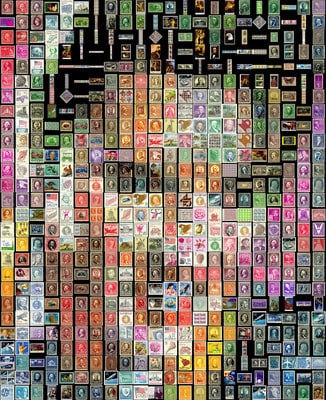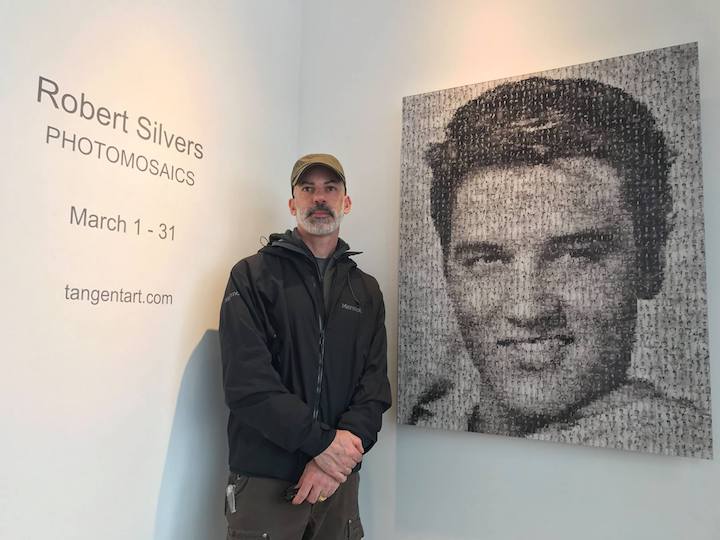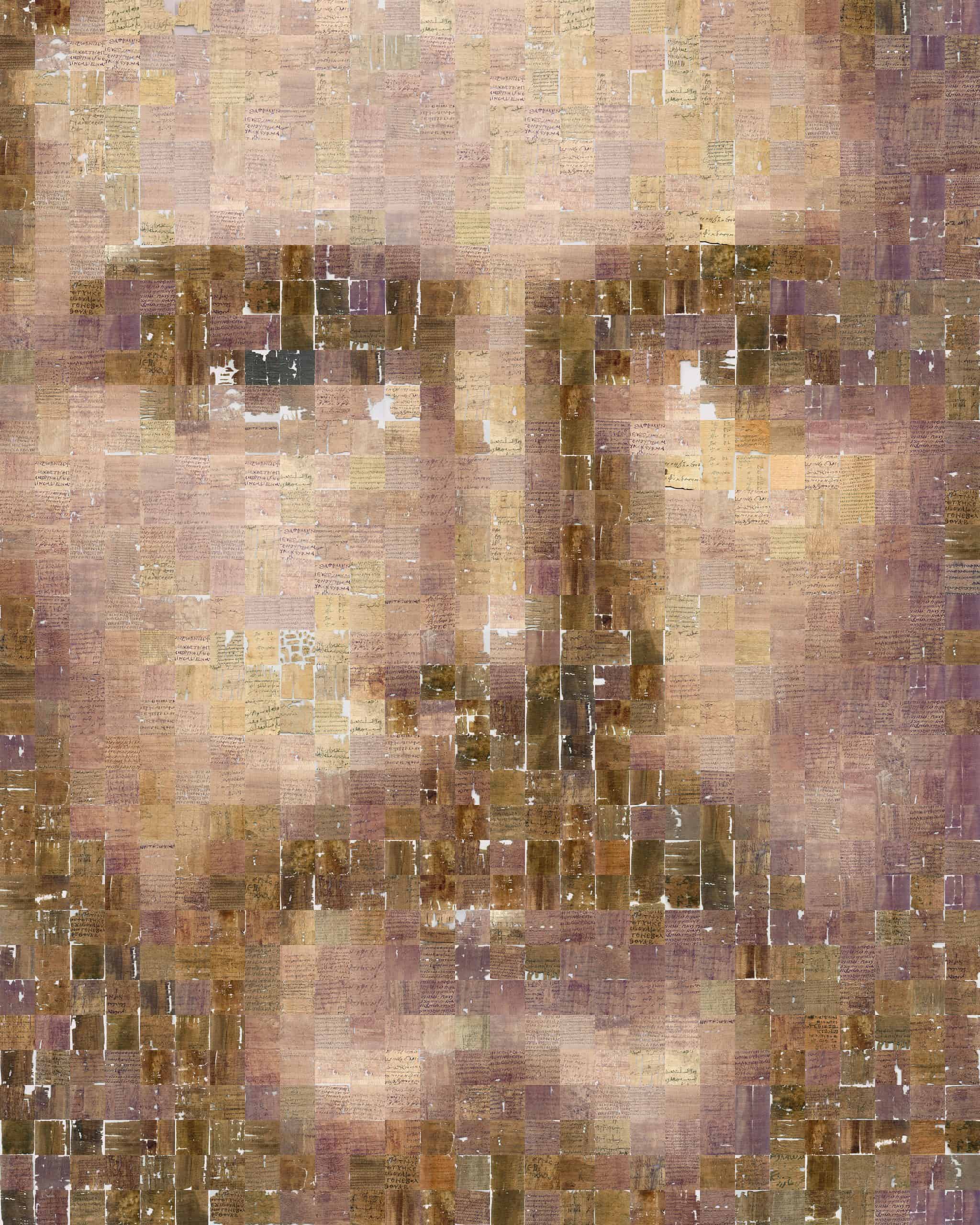Many people think the NFT space is in a bubble. They don’t get it. The NFT space is a digital expression of physical values. It is also one of the reasons why the values of NFT art are going up at the moment. It comes as no surprise that mainstream artists and content creators would want to become a part of the movement.
Recently, a leader in the mosaic art movement, Robert Silvers entered the NFT space. E-Crypto News reached out to him for his thoughts on many issues. Here is what he had to say.
Robert Silvers, Mosaic Artist and Leading Artist
E-Crypto News:
Congratulations on your foray into the NFT space! How do you feel about going fully digital?
I feel like I am the last one to have heard about NTFs, but the minute that I heard about it, I was immediately convinced it was a genius idea. I had not owned crypto anything before this, but now I do.
E-Crypto News:
How did you get involved with NFTs and cryptocurrencies?
I was not paying attention to the crypto world because to me it was just for investment, and I am a more conservative investor so I was staying out of it. I didn’t learn about NFTs until they hit the normal news cycles. The moment I heard about it, it just made sense. I first bought ETH to fund my wallet to mint NFTs.
E-Crypto News:
Do you think you can replicate your offline success in the NFT space? Please tell us the reasons for your answer.
I am not sure if I can replicate my success because I have no Twitter following, and I am told that I need that to sell NFTs. I despise Twitter, so only created an account in March. It is slow-going to get followers.
I have been a reclusive artist, and that worked because my artwork always sold itself. I have never done any solicitation for customers and have a network of art galleries that have sold my work successfully – but they want nothing to do with NFTs. I asked my dealer to talk to some past customers, and they said they just want art to hang on their wall, and don’t seem interested. So, I am on my own this time.
My customer base are art collectors, and NFTs seem to be bought by people already into crypto. Out of my hundreds of past customers, how many are familiar with crypto? Probably none. This means that they don’t know how to open a Coinbase account, buy currency, fund a wallet, and then buy an NFT.
I did make a sale to one one of them. We agreed on 5 ETH for a 1 of 10 edition. They said ok, but then came back to me terrified to connect to their bank account thinking it would drain their money. They also said if they bought crypto, it could crash in value in the minutes before they bought my art.
They asked if they could send me a check and have me buy the NFT for them. At first I said no, because I wanted to use the normal marketplace. But then I realized it was too much to ask them to learn all of these new things, and so I said yes and are helping them complete the transaction. The problem is, the $7500 they sent me for 5 ETH will only buy 3.5 ETH by the time the check arrive. Oh well.
E-Crypto News:
What’s the next thing for you in the NFT space?
Right up front I decided to standardize on a platform and populate it with a body of work because I don’t think someone can judge an artist by seeing one piece. So, I already did the next step.
Now I just need to get the word out. Because my work has always sold well with no promotion, I was not sure what to expect when I started showing it to NFT groups on Facebook. I was very happy in that the response was all positive with hundreds of likes.
E-Crypto News:
What are your favorite NFT marketplaces? Which ones do you think to hold the most promise?
When I was getting started, I wanted to be on SuperRare and Nifty – but they are by application only. I applied, but could not wait around for months to get an answer, so I looked at Rarible, OpenSea, and Foundation.
I was quickly invited to Foundation, and would be ok with their 15% commission if they would help sell my work – after all, I am used to art galleries taking much more than that – but their platform, along with SuperRare, only allows one copy of a work.
Many of my more famous images have a long history and I was concerned about being limited to selling just one copy. To give an example, when I sell printed work, I may sell a run of 20 of them for an average price of $15,000 each, which would total $300,000. I didn’t think I could expect to sell an NFT for $300,000, so I wanted to do it more like photography and less like a painting.
With photography, there is almost always more than one, and that helps keep the price more affordable. At the same time, you limit it to some number. I decided to go with OpenSea because they allow more than an edition size of 1, and also have “lazy minting,” which means I don’t pay for “gas” unless there is a sale.
This made it easier to get started with less risk. I did have concerns that my work would get lost in OpenSea, since they have more than four million items, but in the end, I suspected that SuperRare and Foundation were not likely to sell my work for me. I would have to let people know it is available on my own.
E-Crypto News:
What are your thoughts on digital art and this romance with the cryptocurrency space?
NFT has made it possible for digital artists to sell “originals” and collectibles and that is something that truly enables new markets. The best part is, I don’t think it hurts existing art markets in any way because it seems to be an entirely new customer base. Traditional art customers will probably stick to traditional art.
E-Crypto News:
Are you in this space in short term or for the long haul? Please tell us the reasons for your answer.
For the long haul for sure. There is no reason not to since being an artist is my profession. My main source of income, and not a side job.
During this on boarding process, I assume other artists have had the same experience as me – at first you think you will just offer an NFT and make a million dollars.
Then you realize that the artists who did that basically won the lottery and it can’t be planned for because there are millions of items available on OpenSea, and the vast majority of artists are either not making money, or are losing money.
I am fortunate in that I have a strong history of success – between having a piece in the permanent collection of the New York Museum of Modern Art, having been commissioned by over 100 of the Fortune 500 companies, and having famous people who collect my work – I have a solid foundation to work from so I am not starting as an unknown. But even so, I have to take it slow and steady because most crypto people have not heard of me and my existing art customers don’t know how to use crypto.
E-Crypto News:
Why did you choose mosaic as an art form? How did you get started with mosaics?
My two main interests were computers and photography. I decided to go to school for Computer Science, and keep photography as a hobby. When in college, I met a man named Ken Knowlton who was arranging sea-shells and Dominos such that they formed portrait images. I thought it was interesting, and that I could maybe do it with photographs.
I forgot about the idea for a while, but a few years later, I was a graduate student at MIT and needed an idea for a class project. National Geographic gave us 500,000 photographs to see what we could do with them. I thought it was a good time to try my idea. It worked, and my portrait of the President of MIT got on the cover of the Media Lab newsletter.
That went out to their mailing list, and many people saw it. WIRED asked me to do a cover for them, and I did. The Stock Market photo agency also asked me to do their catalog cover – a Statue of Liberty image made from their photos. I did that, and it was sent to 50,000 Art Directors.
One of the Art Directors was Mimi Park from LIFE Magazine, and she asked me to do the 60th Anniversary cover of LIFE. After I did that, I found myself on various TV shows like 60 minutes.
Oprah. and Good Morning America. I spent two years perfecting the process, got a Master’s Degree from it, patented it, and started my company. My first big commercial client was Mastercard International, and I did a portrait of George Washington made from Mastercards for them. But there so many more big companies – almost all of them really. Over 100 of the Fortune 500 companies have hired me.
People have asked if I am an artist or just someone who “pushes a button.” It is not like that at all – unless you think Photography is not art because all you do is point the camera at a scene and release the shutter.
First, I was a photographer before I got into this. Second, I am the inventor and original artist of the process. Thirdly, most of us use computers to aid with our art, and I can spend months on an image.
For example, when I made a portrait of JFK, I visited the Kennedy President Library and was given access to his personal file cabinet, where I flipped through photos and hand-scanned each one. I then hand cropped each image. Then I had to find and edit the perfect portrait tile by tile until I was happy.
I would look at the image up close and reject any tiles were the subject was distracting. I would look at the mosaic from far away and change any tiles that caused attention to themselves. And moreover, I don’t do any cheating or blending like the imitators who copy my style.
I simply find tiles that happen to have shapes within them that contribute to the resolution of the overall result. I call this sub-picture resolution, and that means I can have details that are smaller than a given tile.
For example, the sparkle in Marilyn Monroe’s eye is formed by a light area within one of the LIFE-cover tiles. I do this on and on for each part of the image.
The work that I am most proud of is my Fine Art prints sold through Tangent Art in San Francisco. They are giant mosaic prints that you can walk right up to and see each photo up close.
Also, the Museum of Fine Arts in New York, on their own, asked for one of my digital interactive works for their permanent collection, so now I am one of their listed artists.
E-Crypto News:
What do you think are the current issues with NFTs? What possible solutions do you think can work in solving these problems?
NFTs have a “gas” transaction fee, and it is a lot. It can be around $100 to mint an NFT, and many artists are getting discouraged when they fail to sell their NFTs for more than that.
I know that people are working on ways to lower this cost, but I don’t know enough about it other than to say that I am not worried and it will be worked out.
E-Crypto News:
Do you think the NFT space is in a bubble, or are we going to see more interest in cryptocurrencies as a result of the NFT explosion? Please tell us the reasons for your answer.
NFTs are real and are here to stay with the only bubble being due to some crazy prices during the initial excitement. Over time, that will stabilize. We already see more interest in crypto currencies as a result of NFT.
I have first-hand experience with that because I only bought crypto to participate in the NFT market. I see the price of ETH going up, and I suspect it is connected to the popularity of NFTs.
E-Crypto News:
What are your thoughts on cryptocurrency regulation?
I am not a big regulation person and would like as little as possible, and only to ensure safety and lack of scams. The governments should stay away except to prevent theft.
E-Crypto News:
What advice do you have to other artists who’re sitting on the fence about NFTs?
If you are apprehensive, you may be right. It will be hard to get past art customers who bought printed art to learn enough about crypto to complete a transaction.
NFTs are fun for me though, so I wanted to do it. If you don’t think crypto is cool, then maybe you won’t want to get involved. I am not saying everyone should jump into it. For me, I knew I had to.
E-Crypto News:
What advice do you have to artists who are ready to take a deep dive into the NFT space?
The first thing you need to do is decide what platform to sell on. It took me over a week of research to make my decision, and I still never know if I picked the best choice.
So yes, there is a lot of uncertainty, but I am not sure how you can lose as long as you do lazy minting and don’t accept low offers.
E-Crypto News:
Where do you see the NFT space in the next ten years?
In the next few months, let alone years, I see a lot of artists giving up when they fail to sell their first work for thousands of dollars. I then see lots of larger companies, like Topps Baseball cards, Marvel Comics, etc – all offering collectibles.
They will not be 1/1 though – but rather editions of thousands. I foresee sites like SuperRare changing their model from 1/1 only to allowing larger editions – or else miss out on this market.
E-Crypto News:
What are your thoughts on the emergence of the decentralized finance (DeFi) space?
Crypto is so new to me, I think experts should speak on that.

E-Crypto News:
What other projects are you involved in as per art?
2021 is the 40th anniversary of the first reported cases of AIDS in the US and I am doing a charity sale. 90% of the proceeds will be transferred to the National AIDS Memorial and the National Minority AIDS Council.
Or the buyer can specify a charity of their choice, but the charity must agree to be paid through crypto. I want to encourage charities to accept crypto.
This portrait was created by me, Robert Silvers, the original inventor of Photomosaics,® by arranging thousands of tiles from the AIDS Memorial Quilt to form an overall image of a human face.
“It could be anyone” No cheating or tricks were used. The tiles were not tinted or colored, and none are repeated.
E-Crypto News:
What other projects are you involved in besides art?
I really enjoy using computers for mechanical design. I got tired of the virtual world for a while, and learned machining and welding, and then designed and won the contract for the Sound Suppressor for the US Army’s M2010 sniper rifle. I also design and sell medical device parts.

E-Crypto News:
Do you have any secrets to tell us? Care to spill the beans?
The price of crypto will continue to go up because they are not making any more numbers.
E-Crypto News:
If you had three wishes, and a genie that could make them come true what would they be for the cryptocurrency space?
I wish that there was more stuff to buy with crypto. I would like to see it accepted by sellers of more products and services. This is important to me because I want to keep my crypto money in crypto. I have no plans to withdraw any of it.
I wish that crypto had lower transaction fees – it seems like the crypto institutions are the only ones who are guaranteed to make money. It’s supposed to be de-cerntralized, and yet key players are collecting tolls.
I wish that there was less volatility in the value of the coins, but that should occur with time as larger amount of people and larger institutions buy into it.










